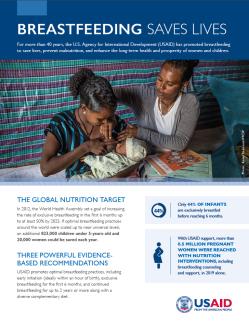The cognitive, health and economic benefits of breastfeeding are well established and recognized, yet only 44 percent of children under 6- months-old worldwide are exclusively breastfed and only 49 percent of infants initiate breastfeeding within one hour of birth.
Breastfeeding has one of the highest returns on investment of any development activity: every dollar invested in breastfeeding interventions yields an estimated $35 in economic gains. Breastfeeding duration is also associated with higher IQ and income as well as greater educational attainment. Inversely, suboptimal breastfeeding is associated with economic losses of about $302 billion each year, or 0.49 percent of world gross national income. With support to scale up global breastfeeding practices, the deaths of 823,000 children under 5-years-old and 20,000 women could be prevented, annually.
In line with recommendations from global and national health authorities, such as the World Health Organization (WHO) and the American Academy of Pediatrics, USAID supports immediate and exclusive breastfeeding for the first six months, followed by the introduction of age-appropriate complementary foods along with continued breastfeeding for up to two years of age and beyond.
USAID STRATEGY
USAID’s breastfeeding efforts are guided by the Agency’s Multi-sectoral Nutrition Strategy. As part of this strategy, the United States strives to achieve WHO Global Nutrition Targets, including increasing the rate of exclusive breastfeeding in the first six months of life to at least 50 percent by 2025. These targets align with cross-government priorities, as outlined in the U.S. Government Global Nutrition Coordination Plan.

